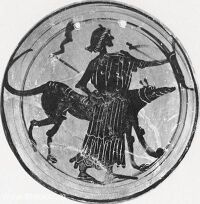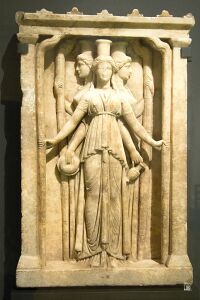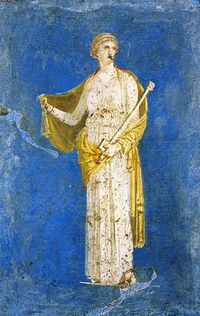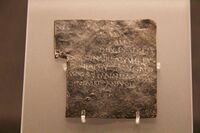Difference between revisions of "Who was Hecate - the Greek goddess of magic, witches and the occult"
m (Admin moved page Who was Hecate, the Greek goddess of magic, witches and the occult? to Who was Hecate - the Greek goddess of magic, witches and the occult) |
|
(No difference)
| |
Latest revision as of 18:51, 12 October 2021
The Greek and Romans myths have influenced the modern world. One of the more curious ways they have influenced us is how we conceive witches, magic, and the supernatural. Hecate was an ancient goddess associated with the underworld, and she evolved to become the deity of magic and witchcraft. She was a significant figure in Greek mythology and ancient religion.
Magic was ubiquitous in the Classical era, and Hecate was. As a result, she is a famous Goddess but also feared. Understanding the myths of Hecate can provide insights into the role of magic and witchcraft in the ancient world and how they influenced the development of ideas about the occult in later ages.
The story of Hecate
The origin of Hecate is much disputed. Her cult possibly originated in Thessaly in Greece or, more likely in Caria, now in modern Turkey. Hecate may have been a chthonic goddess associated with the underworld, and she may have pre-dated the Mycenean period. In his didactic poem Works and Days, Hesiod calls her a great goddess honored by Greece. In some myths, she was the daughter of two Titans. She remained neutral in the war between the Olympian Gods and the Titans and was looked on favorably by Zeus.
There were several significant shrines to the Goddess in the Greek World [1]. In Archaic Greece, she was seen as a benign figure. She gradually came to be seen as a sinister Goddess and dark things, but this process took centuries. According to the Greek Diodorus Siculus, who wrote in Hellenistic, she was like her father lawless and that she would often kill or poison humans[2].
The evolution of Hecate
The Goddess was associated with boundaries and crossroads from an early date. As a result, artists often portrayed her in triplicate to express her essential ambiguity. Her representation in triple form was probably based on the hanging of three masks at crossroads and boundaries. Hecate was expected to guard the entrances of home and travelers at crossroads, and as a result, there were many shrines to the Goddess.
Documentary evidence and literature show Hecate as a Goddess of the Underworld. This was possible because of her association with boundaries in-between spaces, and Hecate was often depicted as operating between the realms of life and death. In some texts, she is shown holding the keys to Tartaros, which can be approximated to the Christian hell [3]. Over time, she became along with Hermes, seen as the guide for the dead on their journey to the afterlife. Because of her associations with the dead and in-between places, which were considered potentially dangerous, she became associated with ghosts. There are many representations of the Goddess leading a retinue of Ghosts down roads or in the underworld.
By the 5th century BC, we can see that there was two interpretation of the Goddess. One was that she was a powerful household deity who protected people. On the other hand, she was seen as a sinister and even hateful figure because of her association with the dead. Hecate is portrayed in the Greek tragedians as both a benign and a malign figure. It appears that by the First Century AD that Hecate had become definitively associated with black magic, sorcery, and necromancy, in the public mind, and her more benign aspects have been forgotten. She also became associated with witches and especially the infamous Thessalian witches. In one famous passage in Lucian, she is described as a living corpse hateful to the Gods.
Hecate came to be associated with the Keres in some accounts. These were female death-spirits who preyed on those who met an untimely or violent death. This is not to say that she was seen as something evil but was capable of both good and bad. Several animals such as dogs and some plants were sacred to her, such as garlic to the Goddess. In some texts, she was also the Goddess of the moon and is shown carrying two torches in the nighttime. Hecate became associated with the night, and all that was supernatural. Hecate appeared in several myths. She helped the Goddess Demeter search for her daughter Persephone who was kidnapped by Hades. In many myths, Hecate is often portrayed as leading the ghosts of the dead across the world while holding torches [4].
Hecate and Magic
Hecate was a liminal figure and outside the natural order of things. She was often shown as having unique or secret knowledge, allowing her to cast spells and practice magic. Over time, especially during the Greco-Roman era, magic became much more popular. It was at this time that Hecate became associated with witches. Many women and men used spells and special potions to force people to do something or do harm or achieve some goal. Witches, in particular, would often invoke the Goddess. An excellent example of how witches were helped by the Goddess is in Medea. She was perhaps the most famous witch in all of Medea.
In plays and poems, she shows as making sacrifices to Hecate in shrines and using her name to curse people. In one work, she is a priestess of Hecate[5]. However, those who worshiped Hecate may not have regarded themselves as witches and believed they were only worshipping the Goddess and receiving her help. Hades was one of the powers in the realm of death. It was widely accepted by practitioners of magic that she could help with the art of necromancy. That is, Hecate's invocations could help summon ghosts and oblige the dead to help the living often for some malicious purpose [6].
Some practitioners of the dreadful arts used necromancy to obtain oracles from the dead, who were widely believed to have second sight. Hecate was also believed to have a great deal of knowledge about poisons and potions, which were, of course, the stock and trade of witches. Plants associated with Hecate were thought to be very helpful when it came to magic potions.
Hecate and theosophy
The distinction between magic and science was very blurred in the ancient world, which was the case until the Early Modern period in Europe. Indeed, many philosophers became interested in magic during the Later years of the Roman Empire, and they were known as theurgists [7]. Many Neoplatonist philosophers, in particular, became interested in secret knowledge. Anthropologists refer to this as higher magic, which was often regarded as helping practitioners to get closer to the divine.
In the Roman era- many philosophers had the characteristics of magicians, such as Apollodorus of Tyna. Hecate was often an important figure in the high magic of many circles. Hecate is one of the prominent figures in the Chaldean Oracles (2nd–3rd century CE). These were a collection of oracular, religious, and philosophical texts. They were used by many Neoplatonists who sought to use them to understand the divine. In this work, Hecate plays an essential role in the metaphysical structure of the Universe, and she is the mother of the World-Soul[8].
By Late Antiquity, at least for some, the old Chthonic deity had once again been transformed. Hecate was also mentioned in the Hermes Trismegistus, a Greek work on magic that is the basis of hermeticism. This esoteric and philosophical tradition was very influential in occult circles and is still read to this day.
Hecate and evolution of occult
When the Roman Empire was Christianized, the worship of Hecate was eventually prohibited. Her temples and sanctuaries were abandoned and often destroyed by Christians[9]. Hecate was largely forgotten after the Fall of the Roman Empire (476 AD). However, she was rediscovered in the Middle Ages as learning revived. Medieval scholars came to regard her as the Queen of witches. Clerics and others began to study the works of the ancient authors, and these had many references to the Goddess.
In 1486, she was described as the Hammer of Witches (1486) worshiped by witches in Europe. This work was instrumental in initiating the 'Witch Craze' that led to the deaths of thousands accused of being witches. The idea of the witch in Medieval and Renaissance Europe was based on Hecate. Shakespeare mentioned Hecate in Macbeth in association with black magic and sorcery, and other dramas. The modern notion of the witch would be unthinkable without the influence of the myths of Hecate. Today many people interested in the occult worship Hecate and regard her as a benign figure[10]. Many neopagans have also incorporated the Goddess into their religion, and she is one of the principal deities in Wicca. Interestingly, they regard her as a protector, rather like her first iterations in the Archaic period.
The meaning of Hecate
Hecate was important in how the Graeco-Roman World. For many, she was the embodiment of ambiguity and uncertainty. This is seen in her associations with crossroads. She was seen as a protector during times of uncertainty, and this was why she was often seen as a benign figure, at least in the Archaic period, but also later. Hecate was one of the protectors of the Oikos or household in Greece. Hecate is a good example of how myths evolve. She began as a chthonic goddess and became a protector and later the Goddess of magic, sorcery, and necromancy[11]. This Goddess, at least in her later incarnations, became the embodiment of occult and supernatural forces. She was the personification of forces that a pre-scientific society could not understand.
Cults were dedicated to her to help worshippers to secure her support. While Hecate may have been seen as a somewhat sinister figure by the elite, she was popular among the poor. This was because she offered them an opportunity to control or influence their fate in a society where they were oppressed and marginalized. Graeco-Roman society was one where slavery was common and women oppressed. The figure of Hecate was popular with them as she offered them the opportunity to win supernatural support, to defend their interests, or to secure some goal or dream[12].
She was summoned by women for love magic, slaves who wanted revenge on their masters, and gamblers who wanted their horses to win in the amphitheater. Hecate is frequently mentioned on curse tablets. These tablets were inscribed with a curse, and they were used to compel or persuade the gods, spirits, or the dead to carry out some action. Magic was influential in the Ancient World, as its practice allowed many to vent their frustrations, which helped to defuse potentially destructive social tensions[13].
Yet magic was viewed with distrust by many. The elite who believed in magic wanted to suppress it, and those who practiced it were technically criminals. Indeed, those who cast spells against the Roman Emperor were considered to have committed an act of treason, and this was a capital crime. This is why Hecate became a feared yet also controversial figure in the Ancient World.
Conclusion
The evolution of the figure of Hecate was remarkable. This is an excellent example of how myths reflect societies. They are narratives that help people understand and control their world, and they reflect dynamic social forces. Hecate is chiefly a Goddess of magic and the supernatural. She played an essential role in Graeco-Roman society as a result. Her associations with magic meant that she was not only associated with witchcraft but became an important figure for all those who believed esoteric and the supernatural.
Further Reading
Clay, Jenny Strauss. "The Hecate of the Theogony." Greek, Roman, and Byzantine Studies 25, no. 1 (1984): 27-38. Marquardt, Patricia A. "A portrait of Hecate." The American Journal of Philology 102, no. 3 (1981): 243-260.
References
- ↑ Stratton, Kimberly B., and Dayna S. Kalleres, eds. Daughters of Hecate (Oxford, Oxford University Press, USA, 2014), p. 113
- ↑ Diodorus Siculus, Library of Greek Myths (London, Pelican, 1988), p 67
- ↑ Stratton et al., p. 56
- ↑ Stratton, p. 154
- ↑ Apollonius Rhodius, Argonautica 3. 250 ff
- ↑ Stratton et al., 189
- ↑ Johnston, Sarah Iles. "Magic and Theurgy." In Guide to the Study of Ancient Magic, pp. 694-719 (London, Brill, 2019), p 67
- ↑ Johnston, Sarah Iles. Hekate Soteira: a study of Hekate's Roles in the Chaldean oracles and related literature (London, Scholars Press, 1990), p. 114
- ↑ Ankarloo, et al. Athlone History of Witchcraft and Magic in Europe: Greece and Rome to Late Antiquity (London, Burns & Oates, 1998), p. 113
- ↑ Ankarloo et al., p 134
- ↑ Marquardt, Patricia A. "A portrait of Hecate." The American Journal of Philology 102, no. 3 (1981): 243-260
- ↑ Marquardt, p 120
- ↑ Marquardt, p 78



